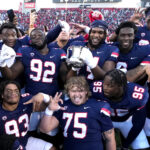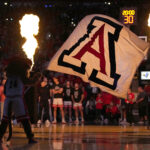Washington State and Oregon State, left behind in the realignment game, are charging forward with their plan to rebuild their 109-year-old conference.
The Pac-12 made the first step official on Thursday, announcing the additions of Boise State, Colorado State, Fresno State and San Diego State for the 2026-27 competition year.
But that only brings the Pac-12 to six schools.
The conference must have at least eight by the summer of 2026 to comply with NCAA rules.
It could expand beyond eight, of course. But any number above the minimum would potentially undermine the media valuation by creating more slices within the revenue pie.
In addition, Washington State and Oregon State want to leave space available in case any of the departed Pac-12 schools reverse course in the future and want to return to a West Coast-based conference. (Stanford and Cal are at the top of the candidate list because of the tenuous nature of the ACC.)
So where should the Pac-12 turn for the seventh and eighth schools, assuming it cannot get the Cardinal and Bears in time for the 2026 football season?
The Hotline has a few suggestions:
1. Memphis. The Tigers would easily clear the competitive bar in football and men’s basketball and bring the nation’s No. 51 media market. Plus, they would provide access to the Central Time Zone, expanding the number of kickoff windows for the Pac-12. But Memphis, a member of the American Athletic Conference, has its sights on the Big 12 or ACC and, for that reason, likely isn’t feasible.
2. UTSA. The Roadrunners make loads of sense on a plethora of fronts. They would provide the Pac-12 with the San Antonio media market (No. 31), a football-crazed state, Central Time Zone kickoff options and the resource-heavy University of Texas system. But clawing them away from the American, which has a super-sharp commissioner, Tim Pernetti, could be difficult.
3. UNLV. Of the eight Mountain West schools in danger of being left behind, UNLV has the greatest upside for the Pac-12. The football program is on the ascent, men’s basketball has a storied history and the Las Vegas media market is No. 40. Also, Sin City and the surrounding area has emerged as a football recruiting hotbed with powerhouse Bishop Gorman High School as its centerpiece. Plus, the Rebels would accept an invitation without hesitation.
4. Tulane. The Green Wave brings a first-rate academic reputation, the New Orleans market (No. 50) and an improved football program, plus recruiting access to the talent-rich region. But Tulane doesn’t make sense for the Pac-12 in isolation. It works only if paired with another school in the Central Time Zone. So the Pac-12 needs to pry two from the American, which won’t be easy.
5. Air Force. The Falcons would be an easy call if not for Colorado State’s presence in the rebuilt conference. Is there a need for two schools from the same region? Colorado Springs is its own media market, while Fort Collins is considered part of the Denver market. But the service academies rate well for the TV networks and have strong academic reputations. Would the Pac-12 have an easier time convincing Cal and Stanford to come back to a conference that counts the Falcons as a member?
6. New Mexico. We view UNLV as the best option, by far, of the remaining Mountain West schools. The Lobos are probably atop the second tier of candidates (ahead of San Jose State, for example). The basketball product is up to standard, and the Albuquerque media market is No. 48. But football matters, and New Mexico’s program is just this side of dreary, with three winning seasons in the last 20 years.
*** Send suggestions, comments and tips (confidentiality guaranteed) to wilnerhotline@
*** Follow me on Twitter/X: @WilnerHotline
Related posts:
 Wilner Hotline: Eight need-to-knows for Week Nine of Pac-12 football
Wilner Hotline: Eight need-to-knows for Week Nine of Pac-12 football

(AP Photo/Rick Scuteri)
Arizona football: Tracing the roots of the Wildcats’ rise, from the 2020 gutter to the 2023 title chase Wilner Hotline: Jedd Fisch leaves UA for Washington
Wilner Hotline: Jedd Fisch leaves UA for Washington

Arizona waves their flag (AP Photo/Rick Scuteri)
Pac-12 rewind: Arizona rolls as Washington State and Oregon keep pace while UCLA suffers gut-punch loss

